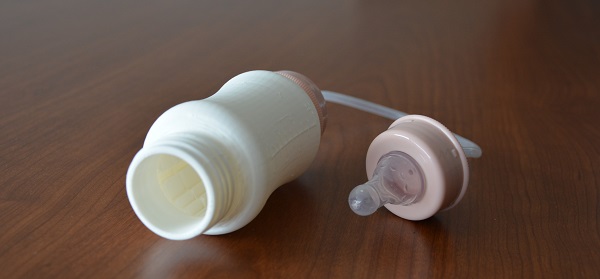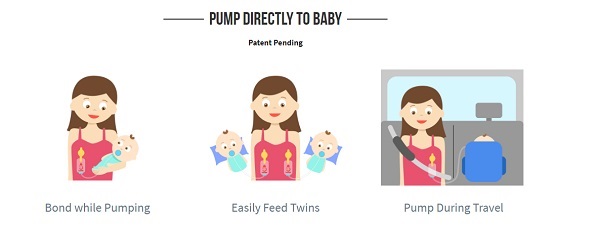
Pittsburgh mom engineers groundbreaking Pump2Baby Bottle
Above photo: Katherine Hornbostel with twin sons, Nick and Ben, and daughter, Evelyn, when Katherine graduated from MIT, about the same time she filed for her Pump2Baby Bottle patent. Photo courtesy of Tony Pulsone.
Katherine Hornbostel is one of many moms who decide to breastfeed their babies. The health benefits and practical advantages give breast milk an edge over formula feeding. As most breastfeeding moms do, she turns to a breast pump to ensure having enough milk on hand.
But when her twin sons were born in 2013, Katherine chose to exclusively pump due to latching problems. She found that pumping – especially with twins – was a full-time job.
“I would pump, store the milk, bottle feed my sons, clean the bottles and repeat this whole process every 2 to 3 hours from morning to night,” says Katherine, now a Pine Township mother of three.
“The memories of hurrying to pump while Nick and Ben screamed at the top of their lungs in hunger across the room were so traumatic that I said to myself, ‘there must be a better way to feed my babies while pumping!’ ”
At the time, Katherine was a Ph.D. mechanical engineering student at Massachusetts Institute of Technology (MIT). She began to brainstorm engineering solutions to the problem and participated in a breast pump Make the Breast Pump Not Suck Hackathon in 2014 designed to encourage innovation in breast pump design.

Her research resulted in the prototype for the Pump2Baby Bottle.
“Pumping sucks regardless of how many babies you’re pumping for, but everything is harder with multiples,” says Katherine, an assistant professor of mechanical engineering and materials science at the University of Pittsburgh Swanson School of Engineering.
“The hundreds of hours I logged ‘bonding’ with my pump in those early months gave me ample opportunity to ponder better designs,” she says.

Her Pump2Baby Bottle, a patent is pending, is an accessory that connects to any conventional Medela breast pump. The user begins hands-free pumping with a pumping bra, and once milk has accumulated in the bottle, the baby can suck it out through tubing to a nipple. A special valve in the bottom of each bottle prevents milk from leaking until the baby starts sucking.
The Pump2Baby bottle can be used while feeding for milk collection and storage for later feeding. It sells for $14.99 and should be available in June at LacTek, where pre-orders are being accepted. The device is BPA free and dishwasher safe.
Katherine’s business partner, Juan Chen, a nanomaterial scientist/engineer from Boston, Mass., is the founder of LacTeck, an online company dedicated to providing the best lactation technologies to empower mothers.
“Juan, another MIT mom who experienced similar challenges, was excited about the prototype and decided to create this amazing product,” Katherine says. “We believe the Pump2Baby Bottle will alleviate the stress of pumping and save mothers 180 hours – yes, as nerds, we calculated it – to bond with their babies, or actually sleep.”
Some additional benefits of the Pump2Baby Bottle include:
- Giving your baby freshly pumped milk while pumping and storing milk.
- Helping moms who pump exclusively to closely mimic the nursing experience and enhance bonding with baby during feeding.
- Convenience during travel. Moms don’t have to worry about pumping enough milk before a trip.
- And Pump2Baby maintains ambient atmospheric pressure to prevent air from entering baby’s mouth.
Emily Brelsford, from Atlanta, Ga., is one of the moms who beta-tested the Pump2Baby Bottle with her 4-month-old baby, Kit. She says the main advantage of the product is its convenience.
“In my case, I exclusively pumped, meaning in the first three months postpartum, I spent four hours a day hooked up to my pump, while my precious and helpless baby cried wanting snuggles or food,” Emily says. “This pump not only enabled me to feed and comfort him while I pumped but because of it, I actually felt our bond strengthening.”
Katherine says they have received many other positive comments from other women.
“The most rewarding part for me is hearing back from moms who have either tried our prototypes and loved them or who tell us they wish they had had Pump2Baby when they were pumping,” she says. “This kind of positive feedback encourages us that we’re solving a very real problem and that our product will make a difference for future moms.”
Pump2Baby currently is only available through the website, but the partners plan to collaborate with other online and brick-and-mortar retail stores to bring the product to more moms in the future.